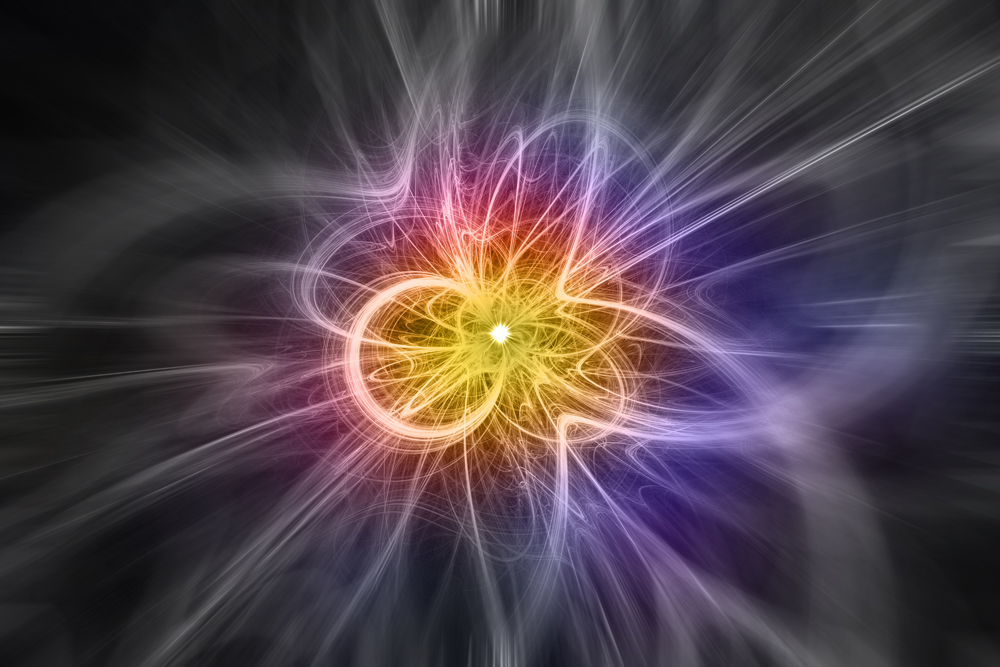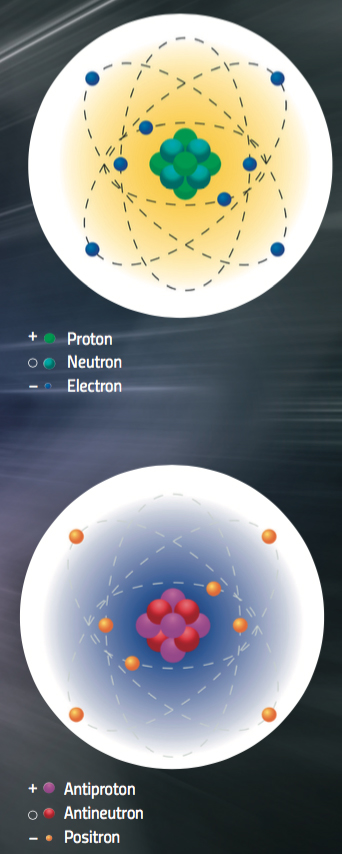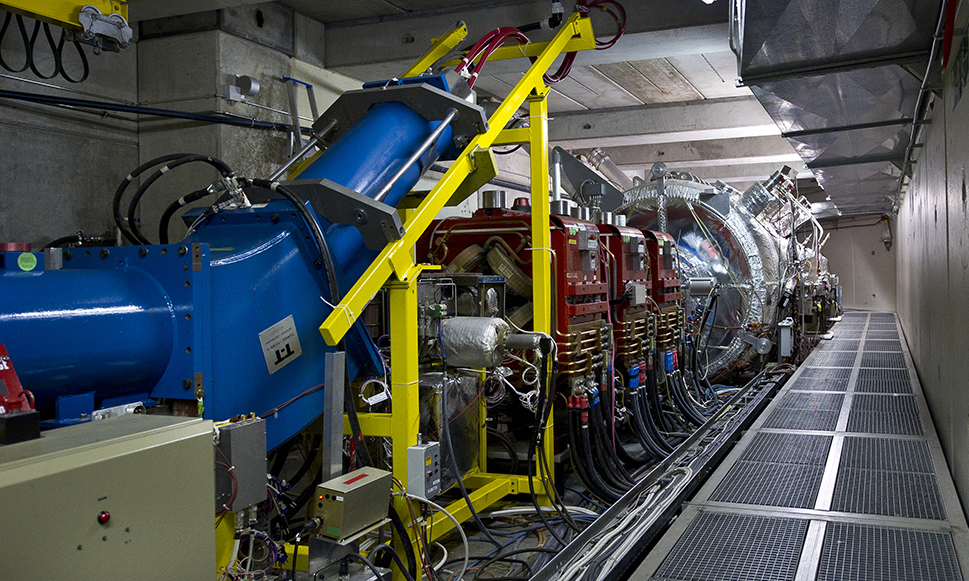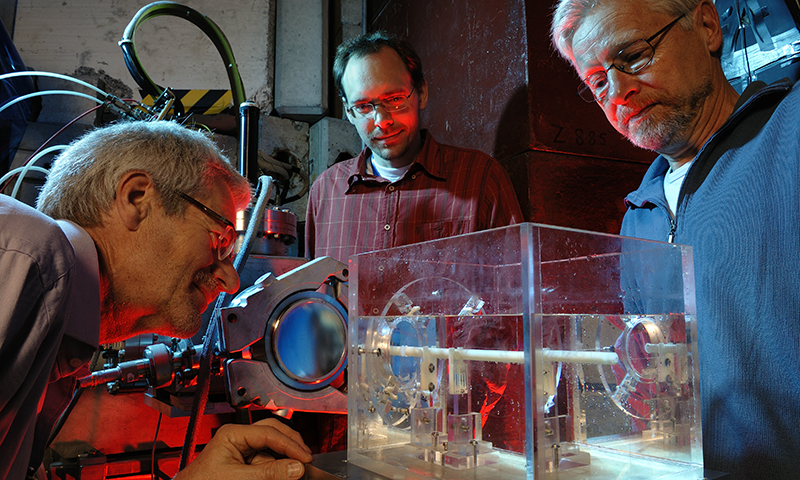Ten things you might not know about antimatter Understand article
Antimatter has inspired many science fiction stories, but these fascinating facts show that it is not just reserved for fantasy.

energy particles colliding
GiroScience/Shutterstock.com
In the book Angels and Demons, Professor Langdon tries to save Vatican City from an antimatter bomb. And in Star Trek, the collision of matter and antimatter supplies energy to propel the starship Enterprise to faster-than-light speed. But antimatter is not just the stuff of science fiction – while these scenarios are far-fetched, there are still many facts about antimatter that will tickle your brain cells.
1. Antimatter should have annihilated all the matter in the Universe
Antimatter particles are almost identical to their matter counterparts, except that they carry the opposite charge and spin. Matter and antimatter particles are produced as a pair and when they meet, they immediately annihilate each other, leaving nothing but energy behind.
This means that the Big Bang should have created and destroyed equal amounts of these particles. So why do we exist in a Universe made almost entirely of matter? As far as physicists can tell, it is because, in the end, there was one extra matter particle for every billion (109) matter-antimatter pairs. Physicists are hard at work trying to explain this asymmetry.
2. Antimatter is closer than you think
Small amounts of antimatter constantly rain down on Earth in the form of cosmic rays – energetic particles from space. These antimatter particles reach our atmosphere at a rate ranging from fewer than one per square kilometre per century to more than 10 000 per square metre per second. Scientists have also seen evidence of antimatter production above thunderstorms.

models showing the particles
and their respective charges
chromatos/Shutterstock.com
But other antimatter sources are even closer to home. For example, bananas release one positron – the antimatter equivalent of an electron – roughly every 75 minutes. This occurs because bananas contain a small amount of potassium-40, a naturally occurring isotope of potassium. As potassium-40 decays, it occasionally spits out a positron in the process.
Our bodies also contain potassium-40, which means positrons are being emitted from us, too. Antimatter is annihilated immediately on contact with matter, so these antimatter particles are very short-lived.
3. Humans have created only a tiny amount of antimatter
Matter-antimatter annihilations have the potential to release a huge amount of energy. A gram of antimatter could produce an explosion the size of a nuclear bomb.
Scientists create antimatter to study in experiments, but the amount produced is minute. All the antiprotons created at Fermilab’s Tevatron particle accelerator (now inactive) add up to only 15 nanograms, and CERN’s so far add up to about 1 nanogram.
The problem lies in the efficiency and cost of antimatter production and storage. Making 1 gram of antimatter would require approximately 25 million billion (1015) kilowatt-hours of energy and cost over a million billion US dollars.
4. There is such a thing as an antimatter trap
To study antimatter, you must prevent it from being annihilated by matter. Scientists do this by holding the charged particles, such as positrons and antiprotons, in devices called Penning traps. These traps are comparable to tiny accelerators. Inside, particles spiral around as magnetic and electric fields keep them from colliding with the walls of the trap.
But Penning traps won’t work on neutral particles such as antihydrogen. Because they have no electric charge, these particles cannot be confined by electric fields. Instead, they are held in Ioffe traps, which take advantage of the particle’s magnetic properties. Ioffe traps work by creating a region of space where the magnetic field becomes larger in all directions. The particle is attracted to the area with weakest magnetic field, much like how a marble rolling around a bowl eventually reaches the bottom.
5. Antimatter might fall up
Antimatter and matter particles have the same mass but differ in properties such as electric charge and spin. The Standard Model – the theory that best describes particles and their interactions – predicts that gravity should have the same effect on matter and antimatter; however, this has yet to be seen. Experiments at CERN, such as AEGIS, ALPHA and GBAR, are trying to find out.
Observing gravity’s effect on antimatter is not quite as easy as watching an apple fall from a tree. These experiments need to hold antimatter in a trap or slow it down by cooling it to temperatures just above absolute zero. And because gravity is the weakest of the fundamental forces, physicists must use uncharged antimatter particles in these experiments to prevent interference from the more powerful electrical force.
6. Antimatter is studied in particle decelerators
You’ve heard of particle accelerators, but did you know there are also particle decelerators? CERN houses a machine called the antiproton decelerator, a storage ring that can capture and slow antiprotons to study their properties and behaviour.
In circular particle accelerators like the Large Hadron Collider, particles get a kick of energy each time they complete a rotation. Decelerators work in reverse; instead of an energy boost, particles get a kick backward to slow their speeds.

Maximilien Brice/CERN
7. Neutrinos might be their own antiparticles
A matter particle and its antimatter partner carry opposite charges, making them easy to distinguish. Neutrinos – nearly massless particles that rarely interact with matter – have no charge. Scientists believe that they may be Majorana particles, a hypothetical class of particles that are their own antiparticles.
To determine whether this is the case, scientists are looking for a behaviour called neutrinoless double-beta decay. Some radioactive nuclei simultaneously decay, releasing two electrons and two neutrinos. If neutrinos were their own antiparticles, they would annihilate each other in the aftermath of the double decay, and scientists would observe only electrons.
Finding Majorana neutrinos could help explain why matter-antimatter asymmetry exists. Physicists hypothesise that Majorana neutrinos can be either heavy or light. The light ones exist today, and the heavy ones would have existed only right after the Big Bang. These heavy Majorana neutrinos would have decayed asymmetrically, leading to the tiny matter excess that allowed our Universe to exist.
8. Antimatter is used in medicine
Positron emission tomography uses positrons to produce high-resolution images of the body. Positron-emitting radioactive isotopes (like the ones found in bananas) are attached to chemical substances, such as glucose, that are used naturally by the body. These compounds are injected into the bloodstream, where they are naturally broken down, releasing positrons that meet electrons in the body. These particles annihilate each other, producing gamma rays that are used to construct images.
Physicians can already target tumours with precise beams of protons that release their energy only after safely passing through healthy tissue. But scientists working on CERN’s antiproton cell experiment (ACE) studied the effectiveness and suitability of using antiprotons instead, which adds an extra burst of energy. The technique was found to be effective in hamster cells, but researchers have yet to conduct studies in human cells.

Maximilien Brice/CERN
9. Leftover antimatter might still be lurking in space
To solve the antimatter-matter asymmetry problem, scientists are looking for antimatter left over from the Big Bang. They search for these particles using the alpha magnetic spectrometer (AMS), a particle detector on top of the International Space Station.
The AMS contains magnetic fields that bend the path of cosmic particles to separate matter from antimatter. Its detectors assess and identify the particles as they pass through.
10. Antimatter could fuel spacecraft
Just a handful of antimatter could produce a huge amount of power, making it a popular fuel for futuristic vehicles in science fiction.
Antimatter rocket propulsion is hypothetically possible, but there is currently no technology available to mass-produce or collect antimatter in the volume needed. One day, if we can figure out a way to create or collect enough antimatter, antimatter-propelled interstellar travel could become a reality.
Acknowledgement
This article is reproduced with kind permission of Symmetry magazinew1, in which it was originally published.
Web References
- w1 – Symmetry magazine is a free online publication covering particle physics. It is jointly published by Fermi National Accelerator Laboratory and SLAC National Accelerator Laboratory, USA. To see the original article, visit the Symmetry website.
Review
The article provides a good insight into antimatter, giving examples of how antiparticles are important to our lives and how they can become even more important to our society. It tries to bring antimatter closer to our everyday existence, showing how small antiparticles are produced on Earth around us, and even by us.
Written in a style that stimulates further research, the article not only offers a good starting point for topics concerning particle physics, but also can be used to trigger discussions amongst pupils. Students can consider how science fiction and science interact – and which one anticipates the other – and the article can be linked to non-science disciplines such as history, literature and art.
Marco Nicolini, physics, maths and astronomy teacher, science journalist, European School of Brussels II, Belgium





